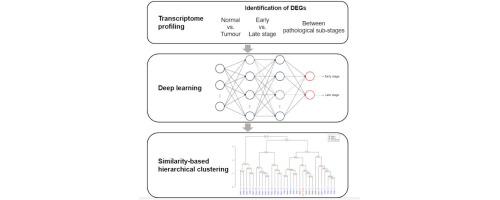Computational and Structural Biotechnology Journal ( IF 4.4 ) Pub Date : 2020-09-24 , DOI: 10.1016/j.csbj.2020.09.029 Sugi Lee , Jaeeun Jung , Ilkyu Park , Kunhyang Park , Dae-Soo Kim

|
Papillary renal cell carcinoma (pRCC), which accounts for 10-15% of renal cell carcinomas, is the second most frequent renal cell carcinoma. pRCC patient classification is difficult because of disease heterogeneity, histologic subtypes, and variations in both disease progression and patient outcomes. Nevertheless, symptom-based patient classification is indispensable in deciding treatment options. Here we introduce a prediction method for distinguishing pRCC pathological tumour stages using deep learning and similarity-based hierarchical clustering approaches. Differentially expressed genes (DEGs) were identified from gene expression data of pRCC patients retrieved from TCGA. Thirty-three of these genes were distinguished based on expression in early or late stage pRCC using the Wilcoxon rank sum test, confidence interval, and LASSO regression. Then, a deep learning model was constructed to predict tumour progression with an accuracy of 0.942 and area under curve of 0.933. Furthermore, pathological sub-stage information with an accuracy of 0.857 was obtained via similarity-based hierarchical clustering using 18 DEGs between stages I and II, and 11 DEGs between stages III and IV, identified through Wilcoxon rank sum test and quantile approach. Additionally, we offer this classification process as an R function. This is the first report of a model distinguishing the pathological tumour stages of pRCC using deep learning and similarity-based hierarchical clustering methods. Our findings are potentially applicable for improving early detection and treatment of pRCC and establishing a clearer classification of the pathological stages in other tumours.
中文翻译:

基于深度学习和基于相似度的层次聚类方法对乳头状肾细胞癌的病理学阶段预测
乳头状肾细胞癌(pRCC)占肾细胞癌的10-15%,是第二常见的肾细胞癌。由于疾病的异质性,组织学亚型以及疾病进展和患者预后的差异,pRCC患者的分类很困难。然而,基于症状的患者分类在决定治疗方案时必不可少。在这里,我们介绍了一种使用深度学习和基于相似性的层次聚类方法来区分pRCC病理性肿瘤分期的预测方法。根据从TCGA检索到的pRCC患者的基因表达数据鉴定出差异表达基因(DEG)。使用Wilcoxon秩和检验,置信区间和LASSO回归,根据在pRCC早期或晚期的表达来区分这些基因中的33个。然后,构建了一个深度学习模型来预测肿瘤的进展,准确度为0.942,曲线下面积为0.933。此外,通过基于相似度的层次聚类,使用阶段I和阶段II之间的18°,以及阶段III和阶段IV之间的11°,通过Wilcoxon秩和检验和分位数方法确定了准确度为0.857的病理亚阶段信息。此外,我们将此分类过程作为R函数提供。这是使用深度学习和基于相似性的层次聚类方法区分pRCC病理肿瘤阶段的模型的首次报告。我们的发现可能适用于改善pRCC的早期检测和治疗,并建立更清晰的其他肿瘤病理分期。构建了深度学习模型来预测肿瘤进展,准确度为0.942,曲线下面积为0.933。此外,通过基于相似度的层次聚类,使用阶段I和阶段II之间的18°,以及阶段III和阶段IV之间的11°,通过Wilcoxon秩和检验和分位数方法确定了准确度为0.857的病理亚阶段信息。此外,我们将此分类过程作为R函数提供。这是使用深度学习和基于相似性的层次聚类方法区分pRCC病理肿瘤阶段的模型的首次报告。我们的发现可能适用于改善pRCC的早期检测和治疗,并建立更清晰的其他肿瘤病理分期。构建了深度学习模型来预测肿瘤进展,准确度为0.942,曲线下面积为0.933。此外,通过基于相似度的层次聚类,使用阶段I和阶段II之间的18°,以及阶段III和阶段IV之间的11°,通过Wilcoxon秩和检验和分位数方法确定了准确度为0.857的病理亚阶段信息。此外,我们将此分类过程作为R函数提供。这是使用深度学习和基于相似性的层次聚类方法区分pRCC病理肿瘤阶段的模型的首次报告。我们的发现可能适用于改善pRCC的早期检测和治疗,并建立更清晰的其他肿瘤病理分期。











































 京公网安备 11010802027423号
京公网安备 11010802027423号